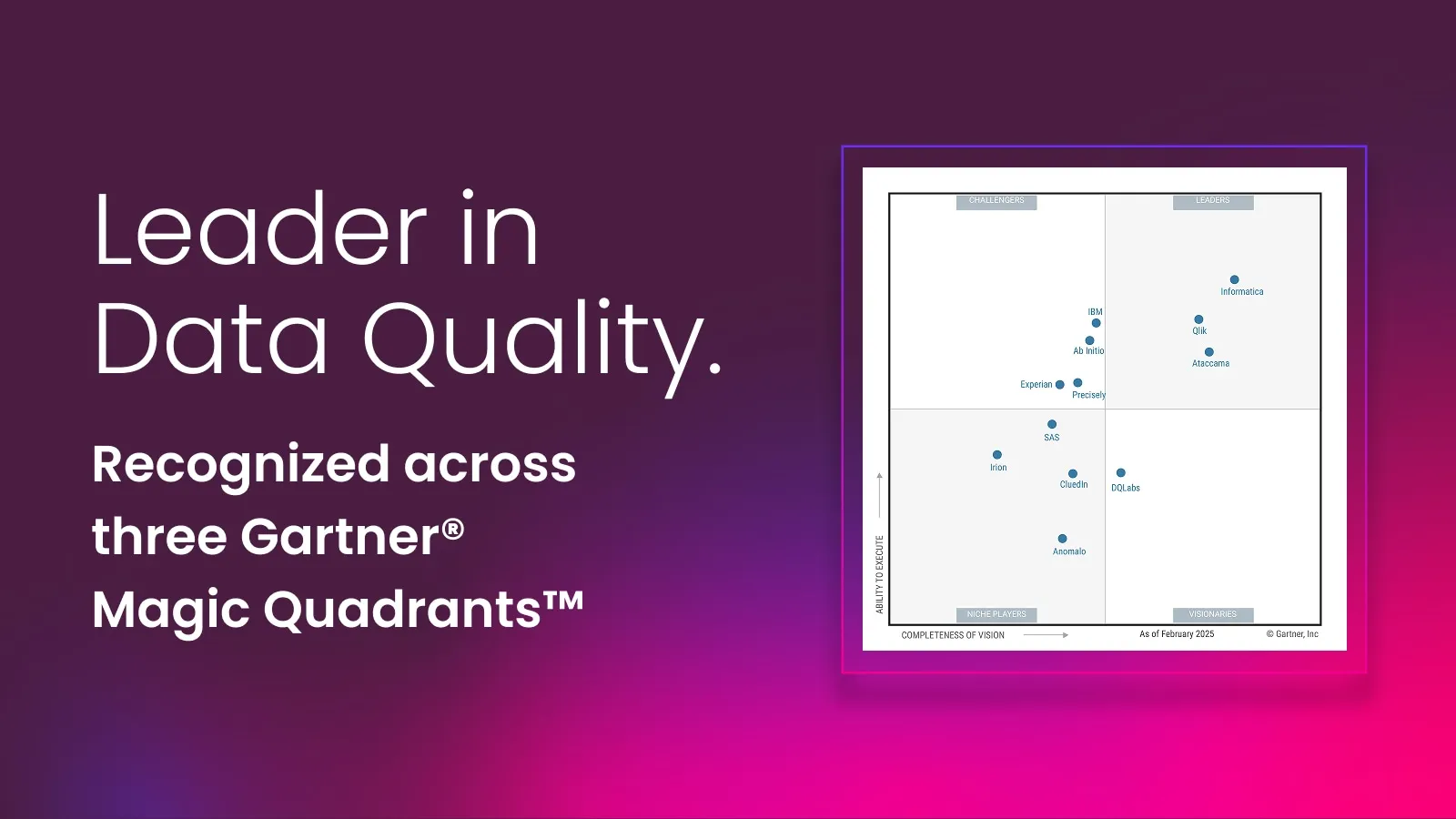Why metadata management only works when data quality comes first

As Gartner’s new Magic Quadrant and Critical Capabilities for Metadata Management Solutions highlight the rising importance of metadata platforms in modern data and AI strategies, the real question becomes: how do you go from having metadata to actually using it?
Most organizations don’t have a metadata problem. They have a data trust problem.
Enterprises are generating more data, and more metadata, than their teams can validate, and the gap shows up everywhere. Analysts stop relying on catalog entries, engineers question lineage, and business users disengage from glossaries because none of it feels accurate or current enough to support real decisions. The issue isn’t the availability of metadata; it’s that traditional cataloging tools haven’t kept pace with what modern enterprises now demand: trust, verification, and a clear signal of whether the data is fit for use.
Organizations can scan, classify, and document thousands of assets, but without quality assurance, that metadata becomes noise. Automated profiling and classification can help surface information, yet they don’t solve the fundamental question: Can this data be trusted for the decisions, models, and regulatory obligations it supports?
As data volumes accelerate, many enterprises have watched this gap widen, with metadata accumulating far faster than teams can curate or validate it.
A catalog that truly enables data governance, analytics, and AI must go beyond documentation. It has to operate as a reliable control point for the business that is trusted, continuously updated, and aligned with the real state of data. Achieving that level of confidence requires more than manual curation. It demands tight integration with data quality, observability, and automated validation so every dataset carries a clear signal of reliability and readiness. Only then can metadata evolve from static records into an operational foundation for compliant, AI-driven, and business-critical workflows.
Data quality as the operational layer that activates metadata
When datasets are incomplete, duplicated, stale, or inconsistent, the metadata that describes them becomes equally unreliable. Users can’t trust classifications, business terms, or lineage if the data they refer to hasn’t been validated. Metadata becomes useful only when it reflects accurate, up-to-date data that is continuously checked for quality.
| Typical challenges | What’s needed instead |
|
|
If a catalog only stores metadata without the ability to assess, fix, or improve the data itself, it stops short of what modern enterprises actually need. Users never become self-sufficient because they can’t trust what they’re looking at, and the organization ends up stalled in the very place it expected to accelerate.
The real reason metadata initiatives fail: a lack of continuous validation
Metadata decays faster than most teams can keep up with. Even the most committed governance managers can’t manually update a catalog at the speed new data enters the business, and good intentions don’t change the fact that volume now grows exponentially across systems. Without automated checks to validate what’s accurate, current, and fit for use, every catalog drifts out of date, quietly at first, then all at once, until users stop trusting it.
Teams need continuous, automated signals on freshness, accuracy, timeliness, and validity, because anything less leaves them operating on a snapshot rather than a living system.
What organizations with maturing data practices should look for:
- Machine learning that can detect anomalies, schema changes, and volume issues automatically
- AI that can generate new rules, test them, and assign rules across datasets at scale
- Continuous data quality monitoring that alerts users to dips in quality, allowing the root cause to be identified and the issue remediated
- Issue remediation for large volumes of data, done through transformation plans that allow data to be cleansed at scale
AI that changes the equation: Metadata + data quality + automation = data trust
When AI is used well, metadata and data quality reinforce one another and create a healthy, self-maintaining ecosystem. Each piece plays a critical role in the symbiosis: Machine learning surfaces anomalies and suspicious patterns that would never be caught manually. Generative AI writes data quality rules, validates mappings, generates test data, and explains logic in natural language. Agentic AI can take this a step further and complete entire workflows end-to-end. When used together with metadata that includes lineage, relationships, and classifications, the AI can reason about context, not just values.
This all results in a system that solves common data team pain points:
- Rules can be created once and reused anywhere
- Quality checks are embedded directly into pipelines and applications
- Metadata enriches AI, and AI strengthens metadata
- Data lineage transformations are presented in natural language
- Self-correcting and self-sustaining behavior replaces manual curation

Data trust: The unifying metric
Data accuracy and completeness have always mattered, but they’re no longer enough. Today’s data leaders are measured on something broader and far more consequential: data trust. Trust determines whether teams rely on the assets available to them, whether AI models behave responsibly, and whether an organization can prove compliance when regulators ask for evidence.
A reliable metadata ecosystem depends on signals that go beyond documentation. Teams need to see, at a glance, the quality, ownership, lineage, context, and usage patterns of the data they’re working with. When those signals are visible and credible, engagement changes immediately. Analysts move faster. Engineers troubleshoot with confidence. Business users rely on governed definitions instead of recreating their own. This shift in behavior unlocks downstream confidence in reporting, analytics, AI, and regulatory compliance, exactly the outcomes data leaders are accountable for.

This is also why measuring data trust has become essential. If even one of the foundational elements — scalable quality checks, anomaly-aware observability, lineage that proves compliance, governance that enforces policies, or meaningful user adoption — is missing, trust erodes quickly. And once trust erodes, it spreads across the system, undermining everything built on top of it.
Trust, therefore, becomes a metric in its own right: visible, measurable, and actionable across the enterprise. Tools like the Ataccama Data Trust Index bring these signals together into a single indicator of readiness, giving leaders a clear view of where their data stands today and where investment will drive the greatest improvement.
More than the sum of its parts: How data quality makes metadata management work
There’s a growing consensus that metadata should not only document assets but actively drive actions across the data lifecycle. When data quality is embedded end-to-end, metadata transforms from documentation into a dynamic, operational control plane. Approached in this way, metadata can inform and power how an organization’s data practice is run.
Broken down by function, each element plays a critical role in the unified ecosystem:
- Clean data allows for more meaningful profiling and more accurate classification in the catalog
- Lineage enables trusted pipelines that result in more accurate impact analysis and faster root cause analysis
- Governance operates on a foundation of business rules and automated enforcement, where policies are actually executed
- High-quality, well-governed assets translate to higher usage and self-service analytics
- Verified, consistent data enables teams to train AI models more safely and automate responsibly
Data trust platforms like Ataccama ONE Agentic support this symbiotic, virtuous cycle with end-to-end data quality management, from profiling and rule creation to remediation and pipeline enforcement. The unified platform ensures metadata, quality, lineage, observability, and governance move together, facilitating effortless sharing of metadata across all integrated modules.
When these components operate together, organizations shift from reactive cleanup to proactive creation of trusted data. Instead of discovering issues after they break reports or violate policies, teams prevent them, enforce standards upstream, and expose trust signals directly to the systems where decisions happen. This is what a modern, AI-ready metadata and data quality architecture looks like in practice:
What good looks like:
- Datasets are profiled automatically on ingestion, giving teams immediate visibility into quality and structure.
- AI-generated rules and continuous monitoring that keep pace with changing data and evolving use cases.
- Unified lineage enriched with embedded quality signals, enabling faster root-cause analysis and stronger compliance.
- Pipeline-level gates that enforce business rules before data spreads across downstream systems.
- Trust indicators surfaced directly to BI tools, AI assistants, and operational platforms so users know what they can rely on.
- Closed-loop remediation workflows that connect stewards and engineers to resolve issues quickly and at scale.
Together, these elements define the difference between a catalog that documents data and a platform that actively builds trust in it, which is something every enterprise needs as AI becomes more autonomous and regulation becomes more demanding.
Trust as the value driver
Metadata does not inherently drive value. Trust in the data and metadata does.
Enterprise data catalogs have gone from a back-office metadata repository to a strategic enabler of data governance, analytics, and AI. When built on high-quality data, they are the cornerstone of enterprise data strategy, helping organizations not only document their data but activate it for trusted and compliant use across the business.
Organizations win when their teams can rely on their data and metadata and are motivated to use it. It’s time to stop documenting and start building trust, and the only way to get there is with metadata built on a foundation of high-quality data.
Ataccama’s inclusion in Gartner’s new Metadata Management Solutions Magic Quadrant reflects growing industry recognition of unified platforms that connect metadata, quality, lineage, and governance. Our position in the Augmented Data Quality MQ underscores the foundation that makes this possible.
Download the 2025 Gartner research to see why Ataccama was recognized across two Magic Quadrants, including as a Leader in Augmented Data Quality Solutions.
Lauren Ruth
Lauren is the Director of Global Communications at Ataccama. With over a decade in the data industry, she specializes in strategic communications and has helped fast-growth startups define and amplify their data stories. She previously led communications at Alation and Informa Markets and holds a dual B.S. in Business and Communication, with a specialization in Technology, from Cornell University.



